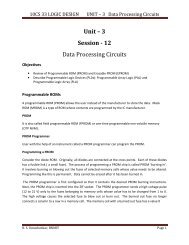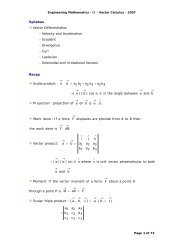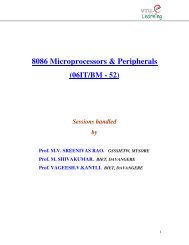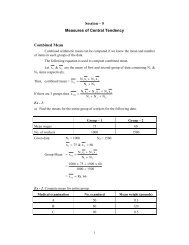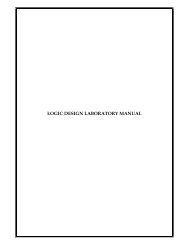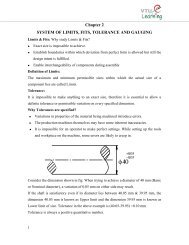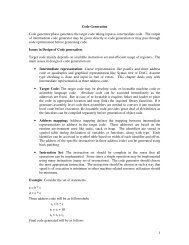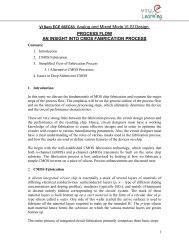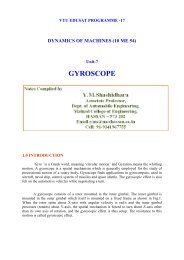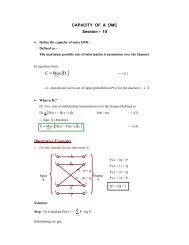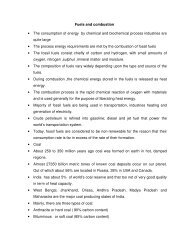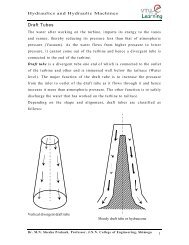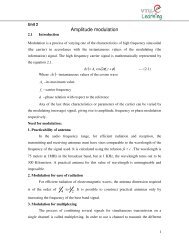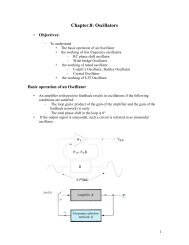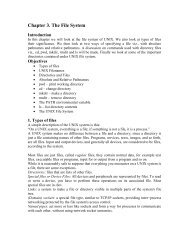Fugacity: It is derived from Latin, expressed as fleetness or escaping ...
Fugacity: It is derived from Latin, expressed as fleetness or escaping ...
Fugacity: It is derived from Latin, expressed as fleetness or escaping ...
Create successful ePaper yourself
Turn your PDF publications into a flip-book with our unique Google optimized e-Paper software.
Effect of variables on equilibrium :<br />
Effect of temperature:<br />
G RT lnK<br />
since ΔG depends only on temperature <strong>as</strong> the<br />
0<br />
298 298<br />
pressure <strong>is</strong> fixed at 1.0 atmosphere, K value varies with temperature. <strong>It</strong> <strong>is</strong> not affected by<br />
Pressure, Concentration, etc,. Variation of K with T <strong>is</strong> given by<br />
ln K<br />
d H<br />
2<br />
dT RT<br />
Van't Hoff equation.<br />
F<strong>or</strong> endothermic reactions ΔH 0 <strong>is</strong> + ve <strong>as</strong> T incre<strong>as</strong>es K also incre<strong>as</strong>es. Th<strong>is</strong><br />
means that the equilibrium conversion <strong>is</strong> m<strong>or</strong>e at higher pressure.<br />
F<strong>or</strong> exothermic reactions ΔH 0 <strong>is</strong> –ve. Theref<strong>or</strong>e K incre<strong>as</strong>es with T. Hence the<br />
equilibrium conversion decre<strong>as</strong>es <strong>as</strong> T incre<strong>as</strong>es. Eg. SO2 + 1/2 O2 ↔ SO3<br />
Effect of pressure: Consider a reaction of ideal g<strong>as</strong>es, then K = KyP Δn <strong>or</strong> Ky = K / P Δn<br />
When Δn > 0. An incre<strong>as</strong>e in pressure decre<strong>as</strong>es Ky. Hence equilibrium product<br />
yield <strong>is</strong> less at high pressures<br />
When Δn< 0. An incre<strong>as</strong>e in pressure incre<strong>as</strong>es Ky and equilibrium product<br />
yield<br />
pressure <strong>is</strong> required<br />
C2H4 + H2O C2H5OH Δn = 1 – (1+1) = -1, Δn < 0<br />
N2 + 3H2 2NH3 Δn = 2 – 4 = – 2 Δn < 0 Here high<br />
When Δn = 0 Here pressure h<strong>as</strong> no effect on reaction. F<strong>or</strong> ideal g<strong>as</strong>es the effect<br />
of pressure depends on the variation of γ and Φ with pressure<br />
Effect of Inert: Presence of inert h<strong>as</strong> the opposite effect of incre<strong>as</strong>e of pressure.<br />
Theref<strong>or</strong>e when Δn > 0, addition of inert incre<strong>as</strong>es Ky and equilibrium<br />
conversion<br />
And Δn < 0, addition of inert decre<strong>as</strong>es equilibrium conversion.<br />
Effect of excess reactants: Presence of excess reactants incre<strong>as</strong>es equilibrium<br />
conversion of the limiting reactant<br />
Presence of products in feed: decre<strong>as</strong>es the equilibrium conversion of reactants.<br />
Eg. CH3COOH + C2H5OH CH3COOC2H5 + H2O<br />
If water <strong>is</strong> added by 1.0 mole to the feed, equilibrium conversion of CH3COOH<br />
reduces <strong>from</strong> 30% to 15%



